Excerpts from Jim Conrad's
Naturalist Newsletter
from the November 20, 2011 Newsletter issued from Hacienda Chichen Resort beside Chichén Itzá Ruins; limestone bedrock; elevation ~39m (~128ft), N20.675°, W88.569°; central Yucatán state, MÉXICO
ELEPHANT EARS FLOWERING
Next to the hut the Elephant Ears are flowering. You can see me standing beneath one of the plants below:
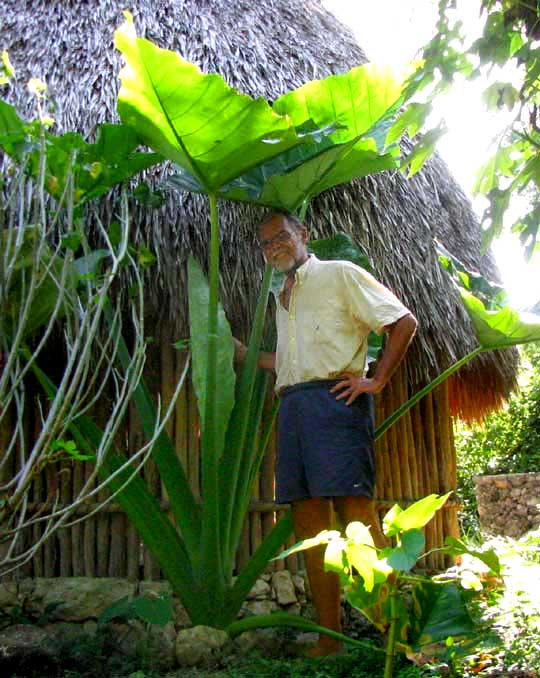
The 14-inch-tall "flower" (35cm) is shown below:
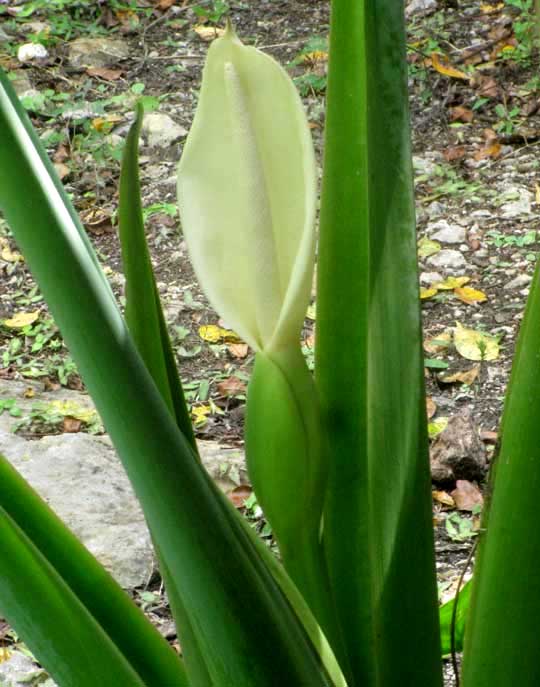
"Flower" is in quotation marks because Elephant Ears belong to the Arum or Jack-in-the-pulpit Family, the Araceae, so what we're seeing in the last picture is a white, fingerlike spike, or "spadix," bearing hundreds of flowers partially enveloped by a white, hoodlike "spathe." The visible part of the spadix bears male flowers. Notice that the spathe constricts near its midsection, enlarging and becoming green below. That part of the spathe loosely envelops the lower part of the spadix, which bears female flowers. Eventually the white, male parts will wither away while the lower green part will expand and the spathe will be filled with the remaining bottom of the spadix bearing numerous fruits -- like corn on a cob inside its husk.
Numerous species in several genera of the Arum Family are known as Elephant Ears. This one is XANTHOSOMA SAGITTIFOLIUM. Spikes and spadices of other species are similar but in small ways different. If only leaves are present, the species is known by its large size, its all-green color -- instead of having certain purplish parts -- and by how the leaf petioles attach to their blades in the particular way shown below:
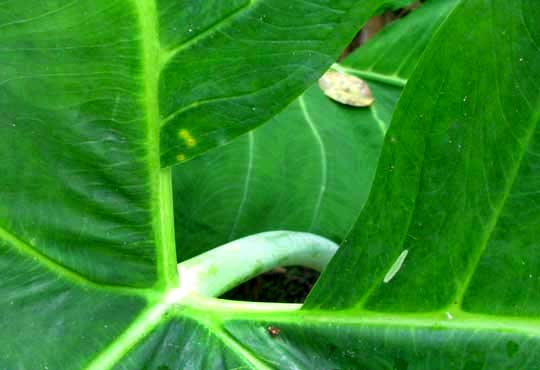
In long-established plants, leaves arise from arm-thick, pale trunks that may recline atop the ground.
from the January 8, 2012 Newsletter issued from Hacienda Chichen Resort beside Chichén Itzá Ruins; limestone bedrock; elevation ~39m (~128ft), N20.675°, W88.569°; central Yucatán state, MÉXICO
ELEPHANTEARS FRUITS
Several "flowers" have appeared and withered back, and they're still being issued, so this week I succumbed to the urge to cut open a "flower's" bottom compartment to see what was going on there. You'll remember that in this species the spike emerging from the spathe bears many male flowers while, below, the spathe completely wraps around the part of the spike bearing females flowers. You can see two lower compartments with the near sides cut away below:
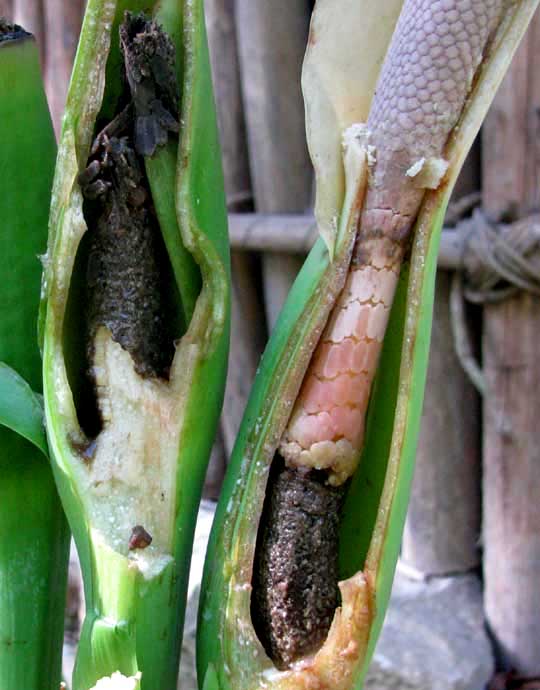
In that picture the flowering spike, or spadix, on the right is still in the flowering stage. You can see that the upper part of the spadix bearing male flowers is different from the lower part bearing female flowers. The male items are angular columns composed of fused anthers while the lower, oval, pinkish, female things are immature stigma heads atop unseen ovaries. Below the ovaries -- that's smelly, mushlike decaying material working with maggots...
At the left is a much older flower. We'd expect to find fruits developing in it, like grains on a corncob, but its spadix also is covered with decaying, stinking, maggoty stuff.
The deal is that under natural conditions fruit and seed production in Arrowhead Elephantear is extremely rare. That's because of a circumstance known as "extreme protogyny," which means that the female flowers mature and stop being receptive to being pollinated about 20 hours before the male flowers' stamens mature enough to produce pollen. This strategy hinders self-pollination, and when you just have a couple of plants growing well apart, and usually one or the other isn't flowering, pollination becomes hard to impossible. The decaying material, then, consists of female flowers that never got pollinated, and so aborted.
If we had enough plants here for the flowers to get properly pollinated, the resulting fruits would mature 40-60 days after pollination. Fruiting heads typically bear between 200-300 berry-type fruits.
a special note from October 30, 2006, issued from Genesis Retreat at Ek Balam, Yucatán, MÉXICO
ARROWLEAF ELEPHANT EAR
One distinguishing feature of this species is that its very large leaves arise from thick, pale rhizomes, which you can see in the picture below lying horizontally on the ground, appearing from behind the sign. Most other "Elephant Ear" leaves seem to arise directly from the ground. Also, some other "Elephant Ear" leaves are of a slightly different shape or design, and most are not as large as these, which get about three feet long.
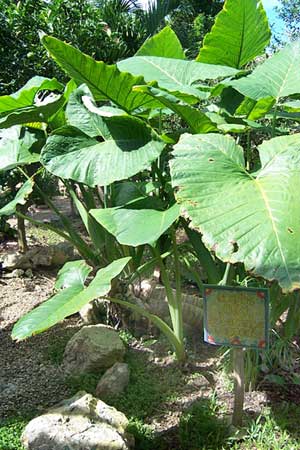
from the February 7, 2016 Newsletter issued from Hacienda Chichen Resort beside Chichén Itzá Ruins, central Yucatán MÉXICO
ELEPANT EAR RHIZOMES
When I planted the Elephant Ears before the hut in 2010 I hadn't thought about them spreading so easily. It's not because their spectacular flower structures -- shown on the above page -- produce fruits with viable seeds, because so far all the flowering I've seen has resulted in aborted fruits. It's because the plants produce strong, wide-ranging rhizomes. The other day I pulled a young one from a spot where I wanted to plant something else and just had to admire the plant's thick roots and rhizome, shown below:
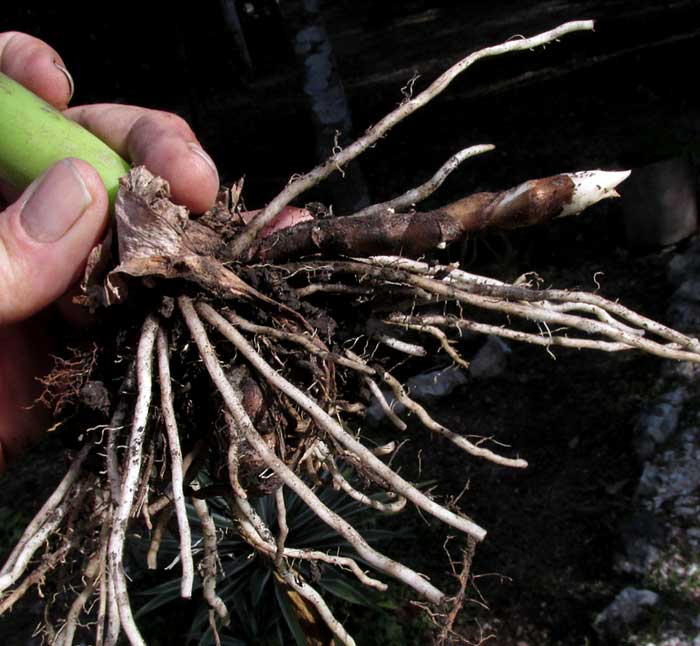
The rhizome is the thick, scaly item with a white tip, running horizontally across the picture.
Rhizomes are defined as modified subterranean stems that often issue roots and shoots from their nodes. In botany, the term node designates a stem joint where a leaf appears, or may appear at one time or another. Below, a close-up of our Elephant Ears' rhizome shows a couple of nodes:
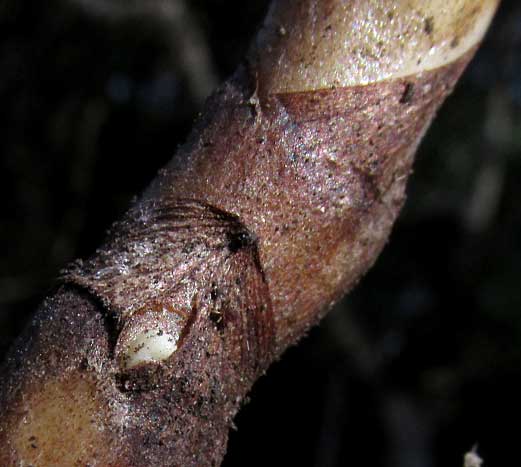
In that picture the lower node is sprouting a white bud from which later probably a shoot will arise, developing into a new plant. On each side of the bud arise brown, veiny, triangular scales. I think that they must be analogous to stipules on above-ground stems, stipules being modified leaves often occurring at petiole bases.
It's good to understand the rhizome and node concepts because when a rhizome is broken up each node may be able to sprout a new plant. That's good if you want to grow many plants from the rhizome of a particularly desirable mother plant, but bad if your plant is a weed you're trying to get rid of.
An interesting word applied to rhizomes is "diageotropic," which describes something that grows perpendicularly to the force of gravity.
Stolons are different from rhizomes because usually stolons run atop the ground. Also, rhizome nodes are close together, like ours, while stolon nodes are widely separated, like those on a strawberry plant.
Older Elephant Ears often develop pale, reclining trunks as thick as an arm, which lie atop the ground and, in very old plants, may stand up to seven or so feet high (2m). But those are regular stems, or trunks, not the rhizomes we're talking about.
from the November 20, 2011 Newsletter issued from Hacienda Chichen Resort beside Chichén Itzá Ruins; limestone bedrock; elevation ~39m (~128ft), N20.675°, W88.569°; central Yucatán state, MÉXICO
MYSTERY PICTURE
At dawn I sat before the hut basking in the day's first sunbeams, vacantly gazing up at the enormous Elephant Ear leaf arching above me. I loved how the sun-drenched leaf, wet with dew, shined as with inner light, and how its raised veins cast dark shadows highlighting the veins' glow. Trying to capture the lush, fresh feeling of it all I took the photo below:
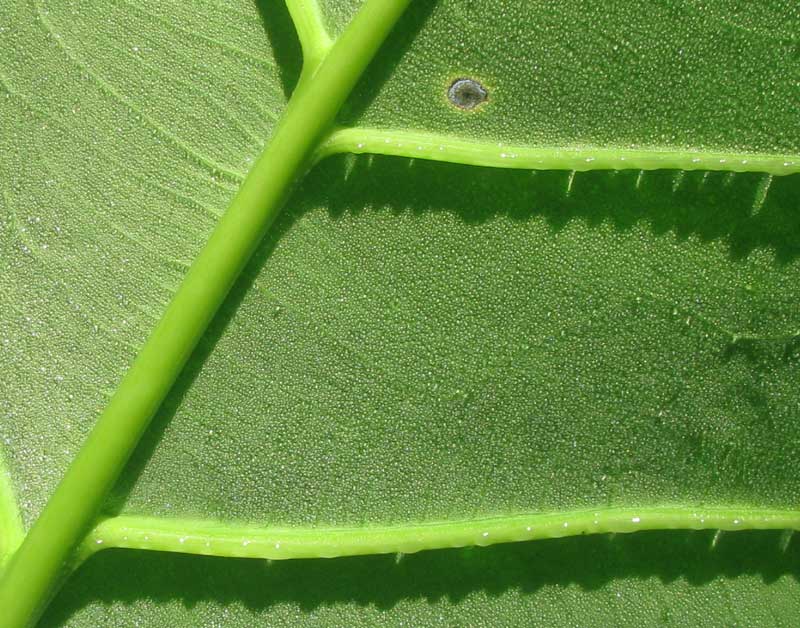
The picture falls far short of what I was trying far, but it does show something mysterious I hadn't noticed while taking the picture. In the vein shadows, what accounts for those slender streaks of light? It looks as if here and there the veins rise above the leaf surface letting sunlight pass beneath them. But that's not how veins work. Veins are sunken into a leaf's blade. Still, it looked so like the veins were rising above the leaf's surface that I went back to the plant to see what was going on.
It took awhile to figure it out. Can you do it? Here's the secret:
Each light streak is associated with a dewdrop suspended from the vein beside it. Each dewdrop bends the light and refocuses it, rather like a prism, shooting it into the shadow.
Neat, huh?